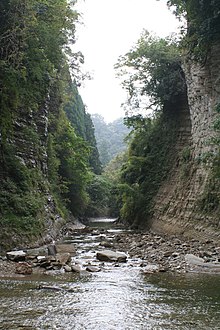Ōtaki, Chiba
Ōtaki
大多喜町 | |
|---|---|
Town | |
 | |
|
Sakura | |
| Phone number | 0470-82-2111 |
| Address | 93 Ōtaki, Ōtaki-machi, Chiba-ken 298-0292 |
| Website | Official website |
Ōtaki (大多喜町, Ōtaki-machi) is a
Etymology
The name of the town of Ōtaki in the Japanese language is composed of three kanji characters: the first, ō (大), meaning "large", the second, ta (多), meaning "many", and the third, ki (喜), meaning "happiness".
Geography
Ōtaki is a landlocked town in the center of the Bōsō Peninsula, about 35 kilometers from the prefectural capital at Chiba and 60 to 70 kilometers from central Tokyo. The southwest area of Ōtaki is mountainous, with elevations gradually lowering towards the northeast of the town. Approximately 70% of Ōtaki is covered by forest. The Isumi River flows through the town to the northeast, and in the western part of the town the Yōrō River flows to the north. The town extends for about 12 kilometers east to west by about 19 kilometers north to south.
Surrounding municipalities
Chiba Prefecture
Climate
Ōtaki has a humid subtropical climate (Köppen Cfa) characterized by warm summers and cool winters with light to no snowfall. The average annual temperature in Ōtaki is 14.9 °C. The average annual rainfall is 1828 mm with September as the wettest month. The temperatures are highest on average in August, at around 25.5 °C, and lowest in January, at around 5.3 °C.[2]
Demographics
Per Japanese census data,[3] the population of Ōtaki has been decreasing over the past 70 years and is now less than it was a century ago.
| Year | Pop. | ±% |
|---|---|---|
| 1920 | 15,451 | — |
| 1930 | 15,601 | +1.0% |
| 1940 | 16,140 | +3.5% |
| 1950 | 19,668 | +21.9% |
| 1960 | 17,247 | −12.3% |
| 1970 | 14,620 | −15.2% |
| 1980 | 13,612 | −6.9% |
| 1990 | 13,218 | −2.9% |
| 2000 | 12,121 | −8.3% |
| 2010 | 10,671 | −12.0% |
| 2020 | 8,885 | −16.7% |
History
Early history
Ōtaki was settled in prehistoric times, as evidenced by the Jōmon period remains in Oikawa. In the Asuka period the Ōtaki region became part of Kazusa Province at the western end of the Tōkaidō region, which was formed as a result of the Taika Reform of 654. In the Sengoku period Ōtaki was established as a castle town, which successively controlled by different regional clans, most notably the Takeda clan and the Toki clan. The Ōtaki region ultimately came under the control of the powerful Awa Province-based Satomi clan in 1544.
Edo Period
In 1590 Tokugawa Ieyasu took control of all of
Modern Period
After the Meiji Restoration the administrative structure of the region changed frequently. Ōtaki was successively part of Ōtaki Prefecture, then Kisarazu Prefecture, before becoming part of the present-day Chiba Prefecture. On April 1, 1889, under the same administrative reforms, the four villages of Oikawa, Nishihata, Fusamoto, Kamitaki and the town of Ōtaki were formed. The five were brought together to become present-day town of Ōtaki on October 5, 1954.
Government

Ōtaki has a
Economy
The economy of Ōtaki was based largely on
Education
- Saniku Gakuin College
- Ōtaki has two public elementary schools and one public middle school operated by the town government, and one public high school operated by the Chiba Prefectural Board of Education. The town also has one private middle school.
Community institutions
- Ōtaki Central Community Center
- Ōtaki Public Library
- Marine Center
- Ōtaki Sports Park
- Ōtaki Elderly Welfare Center
- Ōtaki Elderly Nursing Home
Transportation
Railways
![]() Isumi Railway - Isumi Line
Isumi Railway - Isumi Line
- Shiromigaoka - Ōtaki - Koyamatsu - Higashi-Fusamoto - Kugahara - Fusamoto - Nishihata - Kazusa-Nakano
![]() Kominato Railway - Kominato Line
Kominato Railway - Kominato Line
Roads and highways
 National Route 297, to Ichihara or Tateyama
National Route 297, to Ichihara or Tateyama Futtsu
Futtsu- Prefectural Route 27, Mobara-Ōtaki
- Prefectural Route 32, Ōtaki-Kimitsu
- Prefectural Route 81, Ichihara-Amatsukominato
- Prefectural Route 150, Ōtaki-Ichinomiya
- Prefectural Route 172, Ōtaki-Ichihara Satomi
- Prefectural Route 177, Katsuura-Ōtaki
- Prefectural Route 178, Ōtaki Odashiro-Katsuura
- Prefectural Route 231, Isumi Railroad Ōtaki Station-Ōtaki Koyamatsu
Local attractions

- Ōtaki Castle, built in 1521 and demolished in 1871. While the stone base of the current structure is the base of the original castle's tenshu, the present building is a reproduction of the original castle tower. It houses the Ōtaki Branch of the Chiba Prefectural Museum.
- Herb Island
- Ōtaki Prefectural Forest
- Yōrō Ravine
- Awamata Waterfall
- Ryōgen-ji
- Myōhōshō-ji
- Watanabe Historical Residence
- Central Bōsō Railroad Center
Castle Festival
Ōtaki hosts the Oshiro-
Sister city relations
 – Cuernavaca, Mexico,[6] since August 3, 1978
– Cuernavaca, Mexico,[6] since August 3, 1978
References
- ^ "Ōtaki town official statistics" (in Japanese). Japan.
- ^ Ōtaki climate data
- ^ Ōtaki population statistics
- ^ The Ministry of Foreign Affairs of Japan (2010) Japan-Mexico Relations
- ^ "Ōtaki-machi". Nihon Rekishi Chimei Taikei (日本歴史地名大系 “Compendium of Japanese Historical Place Names”). Tokyo: Netto Adobansusha. 2011. Retrieved 2011-11-18.
- ^ "International Exchange". List of Affiliation Partners within Prefectures. Council of Local Authorities for International Relations (CLAIR). Retrieved 21 November 2015.
External links
- Official Website (in Japanese)
